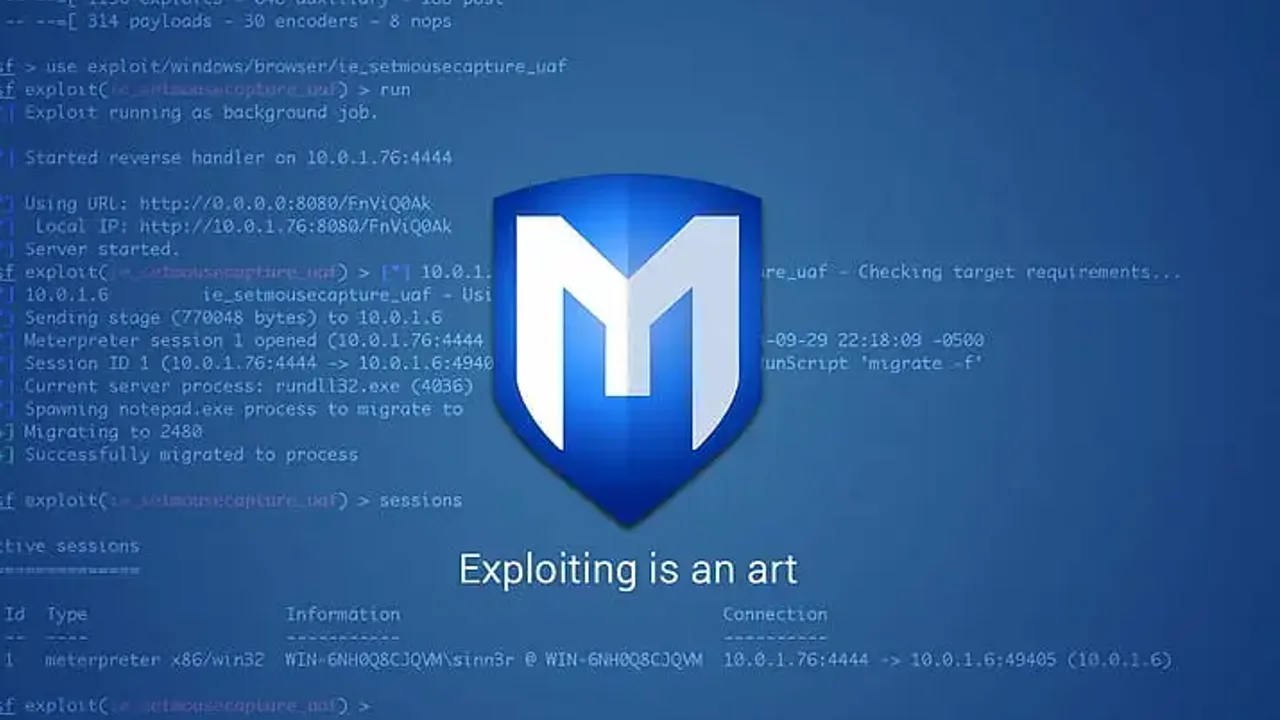Metasploit is a powerful penetration testing framework used by cybersecurity professionals and ethical hackers to identify, exploit, and validate vulnerabilities in computer systems. Originally created by H.D. Moore in 2003, Metasploit has since evolved into one of the most widely used tools in the field of information security. Consequently, it plays a crucial role in maintaining robust cybersecurity defenses.
Metasploit is a collection of tools. It offers a complete framework. Metasploit is a Ruby-based, modular penetration testing platform that allows you to design, test, and execute exploit code. It is flexible and incredibly resilient, with a plethora of tools for performing a wide range of simple and complicated tasks.
There are three editions of Metasploit available.
- Metasploit Framwork
- Metasploit Pro
- Metasploit Community
In this article we are talking about Metasploit framework:
The Metasploit framework, a sophisticated tool, enables both cybercriminals and ethical hackers to investigate systemic vulnerabilities on networks and servers. As an open-source framework, it allows easy customization and compatibility with most operating systems.
The pen testing team can use Metasploit to insert ready-made or custom code into a network to find weak spots. Subsequently, after identifying and documenting the problems, they can use the information to fix weaknesses and decide which fixes to do first.
A Brief History of Metasploit
H.D. Moore started the Metasploit Project in 2003 as a Perl-based portable network tool, with help from core developer Matt Miller. By 2007, they had completely converted it to Ruby, and in 2009, Rapid7 acquired the license.
Where it continues to be part of the Boston-based company’s repertoire of IDS signature developing and targeted remote exploit, fuzzing, anti-forensic, and evasion tools.
Portions of these other tools are housed within the Metasploit framework. Which is included with the Kali Linux operating system. Rapid7 has also created two OpenCore proprietary tools, Metasploit Pro and Metasploit Express.
This framework has emerged as the standard tool for exploit creation and remediation. Before Metasploit, all probes had to be carried out manually by pen testers using a range of tools.
That might or may not have supported the platform they were testing, manually creating their own code, and introducing it onto networks.
Since remote testing was practically unheard of, a security expert was only useful to local businesses and those spending a lot of money on in-house IT or security experts.
What Is Metasploit Used For?
Metasploit is primarily used for penetration testing. Which is the process of identifying vulnerabilities in computer systems and networks by simulating attacks. Moreover it provides a framework for security professionals and researchers to assess the security of computer systems by using a range of exploits, payloads, and modules.
Some common uses of Metasploit include:
- Vulnerability assessment: Metasploit can be used to identify vulnerabilities in computer systems and networks.
- Exploit development: Metasploit can be used to develop and test new exploits for vulnerabilities that have not yet been discovered.
- Penetration testing: Metasploit can be used to simulate attacks on computer systems to identify weaknesses in their defenses and evaluate the effectiveness of security measures.
- Social engineering: Metasploit can be used to conduct social engineering attacks. Such as phishing and spear-phishing, to test the security awareness of users.
- Malware analysis: Metasploit can be used to analyze and test malware to understand how it works and how it can be detected and prevented.
Overall, Metasploit is a powerful tool that can be used for both offensive and defensive purposes in the field of cybersecurity. However, it is important to use it ethically and responsibly to avoid causing harm or violating the law
Components of Metasploit Framework
Penetration testers can find security flaws, launch attacks, and avoid detection thanks to the numerous tools included in the Metasploit Framework. Additionally many of these tools are set up as customizable modules. Some of the most popular tools are listed below.
- Exploits: These are scripts or code that take advantage of a vulnerability in a system or application to gain unauthorized access or perform other malicious actions.
- Payloads: These are code or scripts that are executed on a target system after a successful exploit. Payloads can be used to achieve a variety of objectives. Such as remote access, data exfiltration, or system takeover.
- Auxiliary modules: These are modules that are used to perform tasks other than exploitation, such as scanning, reconnaissance, and brute-forcing.
- Post-exploitation modules: These are modules that are executed after a successful exploit to maintain access to a target system, escalate privileges, or perform other actions.
- Encoders: These are used to encode payloads in such a way that they can bypass antivirus or other security measures.
- NOP generators: These are used to generate No-Operation (NOP) instructions that can be used to fill up memory or padding to make exploit code work properly.
- Plugins: These are additional tools or features that can be added to Metasploit Framework to extend its capabilities.
How to Install Metasploit Framework
The Metasploit Framework is a popular open-source tool used for penetration testing and exploiting vulnerabilities. Here are the general steps for installing Metasploit on a Linux-based system:
- Update your system: Before installing any software, it is recommended to update your system to the latest version. You can do this by running the following command:
sudo apt update && sudo apt upgrade- Install dependencies: Metasploit requires several dependencies to function properly. Run the following command to install them:
sudo apt install curl gnupg2 git postgresql wget vim autoconf bison build-essential libssl-dev libyaml-dev libreadline6-dev zlib1g-dev libncurses5-dev libffi-dev libgdbm6 libgdbm-dev libpq-dev libpcap-dev- Install the Metasploit Framework: Once the dependencies are installed, you can install the Metasploit Framework. There are multiple ways to install it, but the most common way is to use the official installer script provided by Rapid7. Run the following commands to download and run the installer script:
curl https://raw.githubusercontent.com/rapid7/metasploit-omnibus/master/config/templates/metasploit-framework-wrappers/msfupdate.erb > msfinstall
chmod +x msfinstall
sudo ./msfinstallThis will download and install the Metasploit Framework on your system.
- Initialize the database: Metasploit uses a PostgreSQL database to store information about discovered hosts, vulnerabilities, and exploits. To initialize the database, run the following commands:
sudo service postgresql start
sudo msfdb init- Test the installation: To test that the Metasploit Framework is installed correctly, run the following command:
msfconsoleThis will launch the Metasploit console, where you can start using the tool.
That’s it! You have now installed the Metasploit Framework on your Linux system. Keep in mind that Metasploit is a powerful tool that can be used for both legal and illegal activities. Always use it responsibly and with proper authorization.
Conclusion
Metasploit stands out as a vital tool in the arsenal of cybersecurity professionals. Its ability to automate and streamline the penetration testing process makes it indispensable for identifying and addressing vulnerabilities. Whether you are a seasoned security expert or a newcomer to the field, Metasploit offers the tools and support needed to enhance your security testing capabilities.



